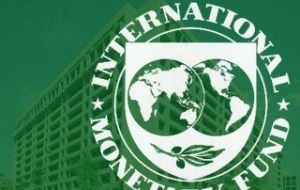MercoPress. South Atlantic News Agency
IMF forecasts Argentina to contract 1.5% in 2009 and expand 0.7% in 2010

Argentina’s economy is forecasted to contract 1.5% in 2009 and will resume growth in 2010 but at a very modest 0.7%, according to the International Monetary Fund’s April World Economic Outlook (WEO).
IMF points out that Argentine equity markets loss since September 2008 were in the range of 25%, the greatest erosion for regional markets while it has been exposed to the highest financial costs of the region, a spread of almost 1.000 points.
Regarding inflation the WEO estimates 6.7% for 2009 and 7.3& in 2010.
According to the IMF report the global financial crisis spread quickly to Latin American and Caribbean markets after mid-September 2008.
Local equity markets sold off heavily and domestic currencies have depreciated sharply, especially in Brazil and Mexico, which are large commodity-exporting countries with flexible exchange rate regimes. Local banks’ funding costs have increased, particularly for small and medium-size banks.
The cost of external borrowing has also risen for Latinamerica, since higher spreads on sovereign and corporate debt have been only partially offset by lower yields on US Treasury bills, and capital flows to the region dwindled in the last quarter of 2008.
Nonetheless, financial markets have differentiated between borrowers: the cost of financing has increased substantially for some countries (for example, Argentina, Ecuador, and Venezuela) but remains relatively low for other countries with better initial positions and larger policy buffers, including Brazil, Chile, Colombia, Mexico, and Peru. Some of the latter have successfully issued foreign debt in recent months.
The IMF underlines that the slump in prices has dampened growth prospects for the region’s commodity producers, mainly Argentina, Bolivia, Brazil, Chile, Colombia, Ecuador, Mexico, Peru, Trinidad and Tobago, Uruguay, and Venezuela, although it has helped commodity importers in the Caribbean and Central America.
Furthermore, the collapse in growth in advanced economies, particularly in the United States, has lowered demand for exports, weakened tourism, and lowered workers’ remittances—key supports in the Caribbean and Central America.
With all these factors playing out, credit growth has slowed abruptly, industrial production and exports have collapsed, and consumer confidence has plummeted across the region.
But considering the very challenging external environment, most Latinamerican countries are weathering the storm well relative to earlier experiences with global turbulence, thanks to improvements in policy frameworks and balance sheet positions.
Nonetheless, real GDP is forecast to contract by 1.5% in 2009, before staging a modest recovery in 2010. Domestic demand would shrink by about 2, 25% in 2009, due to more expensive and scarce foreign financing, as well as lower demand for domestic products.
With the exchange rate acting as a shock absorber, activity is projected to decline modestly or even expand in a number of inflation-targeting economies (Brazil, Chile, Peru and Uruguay).
The contraction is expected to be more severe in Mexico, given its close linkages with the US economy, notwithstanding the mitigating effect of a flexible exchange rate, in Venezuela and in some very small economies dependent on tourism such as Antigua, Barbuda, The Bahamas, Barbados and Jamaica.




Top Comments
Disclaimer & comment rulesCommenting for this story is now closed.
If you have a Facebook account, become a fan and comment on our Facebook Page!